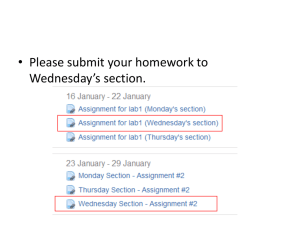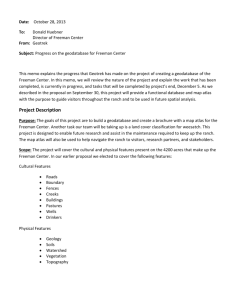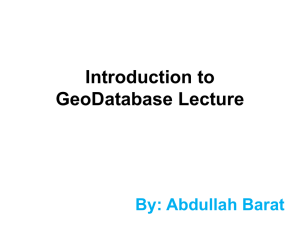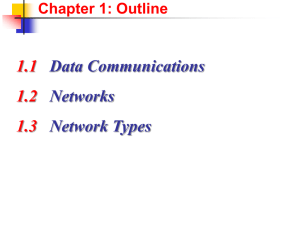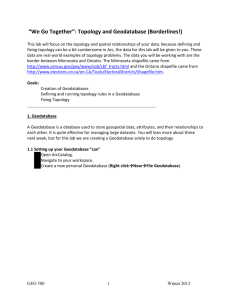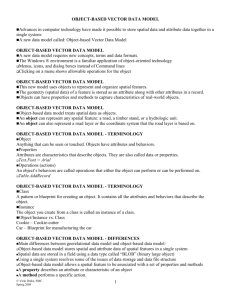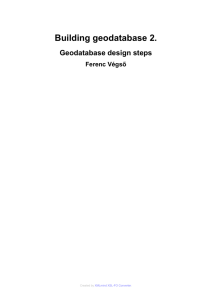chap03
advertisement
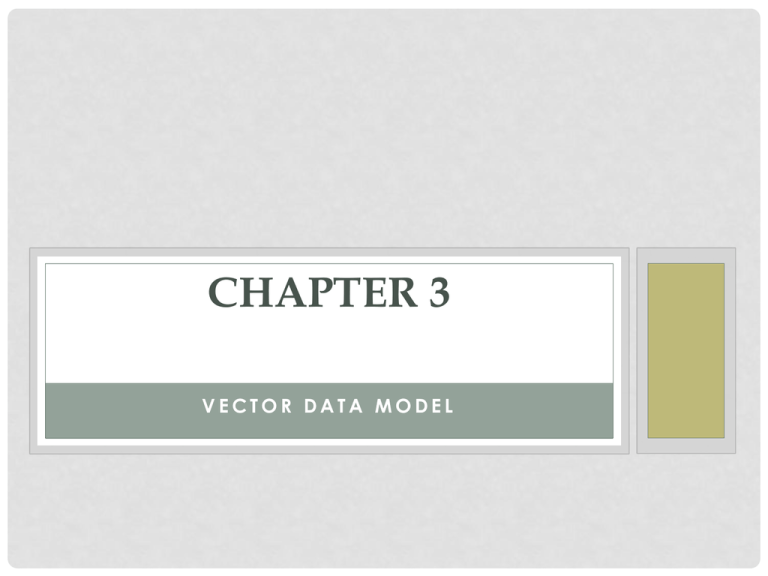
CHAPTER 3 VECTOR DATA MODEL Box 3.1 Geodatabase, Shapefile, and Coverage for ESRI Software 3.1 Representation of Simple Features 3.2 Topology Box 3.2 Adjacency and Incidence 3.2.1 TIGER 3.2.2 Importance of Topology Box 3.3 Topology or No Topology 3.3 Georelational Data Model 3.3.1 The Coverage 3.3.2 Coverage Data Structure 3.3.3 Nontopological Vector Data 3.4 Object-Based Data Model 3.4.1 Classes and Class Relationships 3.4.2 Interface Box 3.4 How to Use an Interface 3.4.3 The Geodatabase Box 3.5 ArcObjects and ArcGIS 3.4.4 Topology Rules 3.4.5 Advantages of the Geodatabase Box 3.6 NHDinGEO Copyright © The McGraw-Hill Companies, Inc. Permission required for reproduction or display. 3.5 Representation of Composite Features 3.5.1 TINs 3.5.2 Regions 3.5.3 Routes Key Concepts and Terms Review Questions Applications: Georelational Vector Data Model Task 1: Examine the Data File Structure of Coverage and Shapefile Task 2: Create File Geodatabase, Feature Dataset, and Feature Class Task 3: Convert a Shapefile to a Personal Geodatabase Feature Class Task 4: Examine Polylines with Measures Task 5: View Regions and Routes Task 6: View TIN Challenge Task References VECTOR DATA MODEL To prepare spatial data for computer processing, the vector data model first uses points and their x-, y-coordinates to represent spatial features as points, lines, and areas. Then it organizes geometric objects and their spatial relationships into digital data files that the computer can access, interpret, and process. Figure 3.1 A reference map showing Idaho and lands held in trust by the United States for Native Americans. SIMPLE FEATURES The vector data model uses the geometric objects of point, line, and area to represent simple spatial features Figure 3.2 Point, line, and area features. TOPOLOGY Topology is the study of those properties of geometric objects that remain invariant under certain transformations such as bending or stretching. Diagrams or graphs are used in topology for studying the arrangements of geometric objects and the relationships between objects. Figure 3.3 The adjacency matrix and incidence matrix for a digraph. TIGER An early application of topology in geospatial technology is the TIGER (Topologically Integrated Geographic Encoding and Referencing) database from the U.S. Census Bureau. Figure 3.4 Topology in the TIGER database involves 0-cells or points, 1-cells or lines, and 2-cells or areas. Figure 3.5 Address ranges and zip codes in the TIGER database have the right- or left-side designation based on the direction of the street. IMPORTANCE OF TOPOLOGY Topology has at least two main advantages. One, it ensures data quality. Two, it can enhance GIS analysis. GEORELATIONAL DATA MODEL The georelational data model stores geometries and attributes separately in a split system: geometries (“geo”) in graphic files and attributes (“relational”) in a relational database. Figure 3.6 An example of the georelational data model, an ArcInfo coverage has two components: graphic files for spatial data and INFO files for attribute data. The label connects the two components. THE COVERAGE The coverage supports three basic topological relationships: Connectivity: Arcs connect to each other at nodes. Area definition: An area is defined by a series of connected arcs. Contiguity: Arcs have directions and left and right polygons. Figure 3.7 The data structure of a point coverage. Figure 3.8 The data structure of a line coverage. Figure 3.9 The data structure of a polygon coverage. THE SHAPEFILE The shapefile is a standard, nontopological data format used in ESRI products. Although the shapefile treats a point as a pair of x-, ycoordinates, a line as a series of points, and a polygon as a series of line segments, no files describe the spatial relationships between these geometric objects. ADVANTAGES OF NONTOPOLOGICAL VECTOR DATA Nontopological data such as shapefiles have two main advantages: They can display more rapidly on the computer monitor than topology-based data. They are nonproprietary and interoperable, meaning that they can be used across different software packages (e.g., MapInfo can use shapefiles and ArcGIS can use MapInfo Interchange Format files). OBJECT-BASED DATA MODEL The object-based data model treats spatial data as objects. It differs from the georelational data model in two important aspects. The object-based data model stores both the spatial and attribute data of spatial features in a single system. The object-based data model allows a spatial feature (object) to be associated with a set of properties and methods. Figure 3.10 The object-based data model stores each land use polygon in a record. The Shape field stores the spatial data of land use polygons. Other fields store attribute data such as Landuse_ID and Category. CLASSES AND CLASS RELATIONSHIPS A class is a set of objects with similar attributes. Class relationships include association, aggregation, composition, type inheritance, and instantiation. INTERFACE An interface represents a set of externally visible operations of an object. It allows the user to use the properties and methods of the object. Figure 3.11 A Feature object implements the IFeature interface. IFeature has access to the properties of Extent and Shape and the method of Delete. Object-oriented technology uses symbols to represent interface, property, and method. The symbols for the two properties are different in this case because Extent is a read-only property whereas Shape is a read and write (by reference) property. Figure 3.12 A Geodataset object supports IGeodataset and an Envelope object supports IEnvelope. See text for explanation of how to use the interfaces to derive the area extent of a feature layer. THE GEODATABASE The geodatabase is part of ArcObjects, a collection of thousands of objects, properties, and methods that provides the foundation for ArcGIS Desktop. DATA STRUCTURE IN THE GEODATABASE The geodatabase organizes vector data sets into feature classes and feature datasets A feature class stores spatial data of the same geometry type. A feature dataset stores feature classes that share the same coordinate system and area extent. Figure 3.13 In a geodatabase, feature classes can be standalone feature classes or members of a feature dataset. TOPOLOGY RULES The geodatabase defines topology as relationship rules and lets the user choose the rules, if any, to be implemented in a feature dataset. The geodatabase offers 25 topology rules by feature type. Feature Type Rule Polygon must not overlap, must not have gaps, must not overlap with, must be covered by feature class of, must cover each other, must be covered by, boundary must be covered by, area boundary must be covered by boundary of, and contains point Line must not overlap, must not intersect, must not have dangles, must not have pseudo-nodes, must not intersect or touch interior, must not overlap with, must be covered by feature class of, must be covered by boundary of, endpoint must be covered by, must not self overlap, must not self intersect, and must be single part Point must be covered by boundary of, must be properly inside polygons, must be covered by endpoint of, and must be covered by line Tables 3.1 Topology rules in the geodatabase data model ADVANTAGES OF THE GEODATABASE The hierarchical structure of a geodatabase is useful for data organization and management. The geodatabase, which is part of ArcObjects, can take advantage of object-oriented technology. The geodatabase offers on-the-fly topology, applicable to features within a feature class or between two or more participating feature classes. Thousands of objects, properties, and methods in ArcObjects are available for GIS users to develop customized applications. ArcObjects provides a template for custom objects to be developed for different industries and applications. COMPOSITE FEATURES Composite features refer to those spatial features that are better represented as composites of points, lines, and polygons. Composite features include TINs (triangulated irregular networks), regions, and routes. TIN A TIN approximates the terrain with a set of nonoverlapping triangles. Figure 3.14 A TIN uses a series of nonoverlapping triangles to approximate the terrain. Figure 3.15 The data structure of a TIN. REGIONS A region is a geographic area with similar characteristics. A data model for regions must be able to handle two spatial characteristics: A region may have spatially joint or disjoint areas, and regions can overlap or cover the same area. Figure 3.16 A hierarchy of counties and states in the conterminous United States. Figure 3.17 The regions subclass allows overlapped regions (a) and spatially disjoint components (b). Figure 3.18 The data structure of a regions subclass. ROUTES A route is a linear feature such as a highway, a bike path, or a stream but, unlike other linear features, a route has a measurement system that allows linear measures to be used on a projected coordinate system. Figure 3.19 The data structure of a route subclass. Figure 3.20 The linear measures (M) of a route are stored with X- and Ycoordinates in a geodatabase. In this example, the M values are in miles, whereas the X- and Y-coordinates are in feet. Figure 3.21 A route, shown here as a thicker, gray line, is built on a polyline with linear measures in a geodatabase. U.S. Census Bureau http://www.census.gov/ Open GIS Consortium, Inc. http://www.opengeospatial.org/ ESRI: topology rules http://support.esri.com/datamodels National Hydrography Dataset http://nhd.usgs.gov/data.html New York State Department of Transportation http://www.nysgis.state.ny.us/gisdata/ Geospatial One-Stop http://www.geodata.gov/ Ordnance Survey: OS MasterMap http://www.ordnancesurvey.co.uk/oswebsite/
